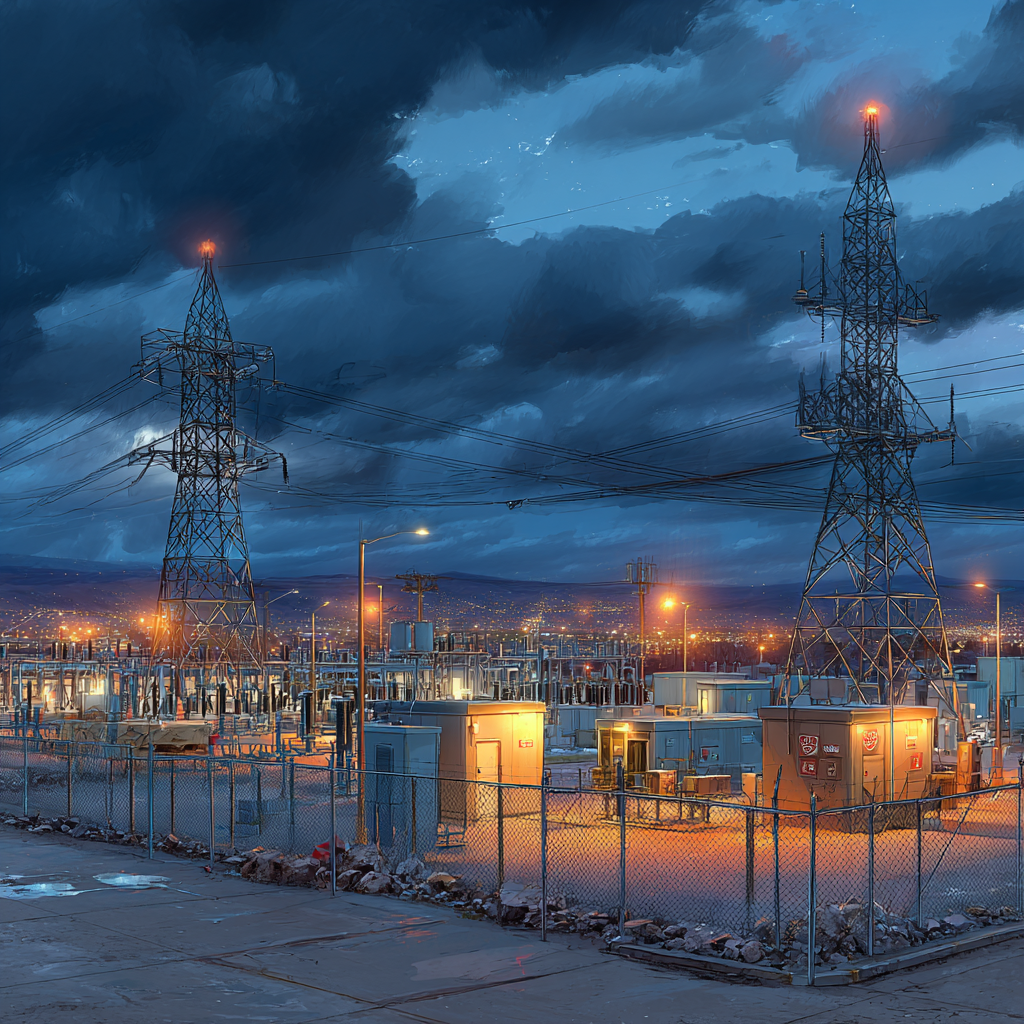AI is transforming utility operations as COOs face soaring electrification, data-center load, extreme weather, and aging infrastructure. The shift from reactive to predictive, AI-driven management is now essential for reliability, resilience, and meeting rising customer expectations.
This is the first part in a four part article series exploring how utility C-suite leaders can harness the power of AI to deliver resilience, reliability, and growth.
Imagine you are a North American utility COO in 2025. You are responsible for delivering power to millions of residential and commercial customers—yet every lever of your operating environment is under unprecedented strain. Electrification is accelerating faster than forecast. Data centers are consuming capacity at a scale unseen in decades. Extreme weather is turning into a year-round condition. And the infrastructure you rely on was built for a different era entirely.
Meanwhile, customer expectations continue to climb. The tolerance for outages—momentary or sustained—is shrinking. Reliability is no longer measured only in SAIDI and SAIFI; it is measured in economic continuity, community trust, and brand credibility.
The mandate is unmistakable: deliver power that is more reliable, more resilient, more dynamic, and more affordable—while managing risk, cost, and a workforce under pressure.
Yet even the best-run operating models were not designed for today’s level of volatility or velocity. What the most forward-facing COOs now understand is that the defining challenge is not operational excellence alone. It is operational intelligence—the ability to see, predict, and adapt the system in real time.
And the most powerful lever for that shift is artificial intelligence.
This article—Part I of the series—examines how AI is already transforming the operational core of utilities and giving COOs the ability to move from reactive management to predictive, adaptive, and optimized systems.
Power Delivery Under Pressure: Moving from System Awareness to System Prediction
Every COO knows the truth: the grid is now the bottleneck for nearly every strategic initiative. EV adoption, DER interconnection, wildfire mitigation, load growth from hyperscale data centers—none of these stall because of generation. They stall because of delivery.
Five years ago, operators could see the system in fragments. Today, AI enables continuous situational awareness and an unprecedented degree of system foresight.
How Leading COOs Are Using AI in Power Delivery
- Predictive load-flow modeling that integrates DER behavior, customer usage patterns, weather forecasts, and real-time performance—surfacing overload conditions before the system strains, and recommending alternative switching strategies.
- AI-assisted substation monitoring that identifies anomalous transformer or breaker behavior weeks or months before visible degradation.
- Dynamic hosting-capacity analytics that unstick DER interconnections by identifying safe, flexible capacity without needing broad, costly upgrades.
- AI-enabled switching and recloser optimization that improves fault isolation and accelerates sectionalization as load increases.
What These Tools Deliver?
More than anything, they deliver time—the one variable operators can never manufacture.
Time to plan instead of react.
Time to redesign circuits with accuracy.
Time to allocate crews where they matter most.
AI is not replacing operational judgment. It is making that judgment exponentially stronger, more precise, and more actionable.
Resilience & Storm Risk: From Post-Event Response to Pre-Event Preparedness
Extreme weather is no longer episodic; it is embedded. A single storm can cost a utility hundreds of millions of dollars in restoration costs, service interruptions, and reputational damage. Over the past decade, COOs have become experts at storm response. The shift now is becoming masters of storm prediction and prevention.
AI is proving to be the inflection point enabling this pivot.
Where AI Is Strengthening Storm and Resilience Operations
- Pre-storm outage prediction models that integrate wind forecasts, flooding projections, vegetation conditions, asset age, soil saturation, and micro-climate data—pinpointing the feeders and assets most likely to fail.
- Vegetation-risk analytics that go beyond location and identify hazard zones, directing trimming budgets toward spans with the highest outage probability.
- AI-driven crew routing and staging that minimize travel time and accelerate restoration under rapidly evolving field conditions.
- Automated drone and satellite damage assessment, processed within minutes, and delivered directly into OMS and work-management platforms.
The Impact
No AI system will ever eliminate weather risk. But AI can significantly reduce the duration, cost, and scale of storm impacts. It allows COOs to move from triage to preparedness—acting hours or days earlier with clarity and confidence.
This shift is not theoretical. It is already underway in the utilities reshaping industry best practice.
Managing Explosive Load Growth: From One-Way Planning to Adaptive, AI-Native Planning
The load growth curve unfolding across the U.S. is rewriting the role of the COO. After decades of relatively flat demand, utilities are entering a new era where 2–3% annual growth becomes 5–7%—with pockets of 20–40% growth in regions experiencing hyperscale data center expansion, manufacturing reshoring, and deep electrification.
Traditional planning cycles—deterministic studies, annual refreshes, reinforcement-heavy portfolios—cannot keep pace with growth of this magnitude.
AI enables a fundamentally different operating environment.
How AI Brings Planning and Operations Together
- Adaptive planning models that update continuously as new data enters the system—customer pipelines, interconnection queues, DER growth, transformer loading, substation constraints, and feeder performance.
- AI-enabled non-wires alternative identification, spotlighting where virtual power plants, targeted demand flexibility, or feeder-level optimization can defer or avoid costly capital upgrades.
- Scenario-based investment portfolios that help COOs and CFOs jointly evaluate capital decisions under multiple weather, load, and economic futures.
- Grid digital twins that allow teams to test capital plans, maintenance strategies, load growth, and operational constraints before investing dollars or deploying crews.
What This Means for COOs
This is not merely technology transformation. It is business transformation.
AI empowers COOs to grow system capacity faster, with higher accuracy, and at significantly lower cost than traditional reinforcement alone. It turns the grid from a static asset into a living system—one that adapts to demand instead of being overwhelmed by it.
Where COOs Need to Lead: The Human and Organizational Shift
AI adoption is not a software exercise. It is a leadership exercise. The most successful COOs are distinguishing themselves in four key ways:
- They set an operational AI agenda—anchored in reliability, resilience, safety, and affordability—not a generic “innovation” agenda.
- They build AI-literate field and control-room teams, using training, simulation, and change management to ensure frontline operators trust and understand the tools.
- They invest in high-quality operational data, especially around assets, vegetation, and real-time conditions, recognizing that AI only performs as well as the data behind it.
- They co-own the strategy with CIOs, CFOs, and customer organizations, ensuring AI solutions strengthen reliability, manage cost trajectories, and support long-term growth.
Operators trust authenticity and clarity. The COO’s voice carries authority because they own the systems, the crews, and the customer experience. When COOs champion AI, the organization listens.
The Moment for AI-Driven Operations Has Arrived
Utilities face extraordinary pressure—and extraordinary opportunity. AI is not a silver bullet, but it is the most powerful operational tool the industry has had in decades.
The COOs who embrace this shift will deliver grids that are safer, more resilient, more predictable, and more prepared for the economic and social growth ahead. They will be the leaders who move their organizations from managing the grid to mastering it.
In a decade defined by electrification, volatility, and exponential demand, mastery is no longer a goal—it is the mandate for operational excellence.
In the end, the portrait that emerges is of a utility operating landscape being remade at a pace that outstrips the tools of the past. COOs are discovering that the constraints they face—runaway load growth, weather volatility, aging infrastructure, and demanding customers—are not solvable with incremental process improvements or legacy planning cycles. They require a shift from system awareness to system prediction, from static design to adaptive operation, from episodic response to continuous readiness. Artificial intelligence is the catalyst for that shift, giving operators time, foresight, and optionality in a world where every decision carries higher stakes. The implication is unmistakable: utilities that embrace AI-native operations will accelerate capacity, reduce risk, and strengthen reliability at a cost and speed unachievable through traditional means. Those that resist will find themselves increasingly outpaced by the demands of electrification and the expectations of the communities they serve.
What’s Ahead in Parts II–IV
This Part I article established the operational foundation: how AI is reshaping grid intelligence, real-time operations, storm preparedness, and load-growth planning for COOs. The next three articles will explore the role that other C-Suite executives, Chief Customer Officer, Chief Public Affairs/Regulatory Officer and Chief Financial Officer, play in the utility-AI transformation.



